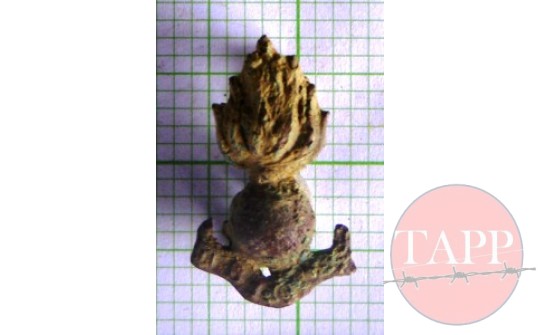The Royal Engineers Cap Badge p.207
Item Information:
Catalogue Number: See Report 8 Source: TAPP Archaeology Surveys Location: No 8 Adam Park Report No: Report No.8 Artifact Type: Badges Production Date: 2011-02-17 00:00:00 Dimensions of Item: 17mm x 9mm Copyright with The Adam Park Project
Other Description:
A second badge was found during the survey of the feature believed to be a slit trench. This is a collar badge of the Royal Engineers.
Historic Context:
According to the Royal Engineers website the embroidered grenade was first worn on the tail of an RE Officer's full dress scarlet coatee in 1824, and the following year a brass grenade was introduced for Other Ranks of the Royal Sappers and Miners. The grenade was later worn on the epaulet and then on the collar. The number of flames to the grenade has varied, but in 1922 a nine-flamed grenade, with the motto ‘Ubique’ below it, was authorized. The Royal Artillery grenade is similar, but has only seven flames. The question remains as to why a collar badge should be found on site when the uniform floppy collars on the tropical khaki shirts prevented the badges being worn. The introduction of the beret for the Royal Artillery as a general form of headwear it was found the old gun cap badge was too big so they wore the collar badge instead. On 09.06.41 the WO sent a telegram to all Commands: 'RA cap badge will be of the 'grenade' type. Collar badge (Catalogue CB 0520) will be utilised for this service. Cap badges of the 'gun' type (Catalogue CB 0289) already in possession will continue to be worn until unserviceable, and no complete change over by units to the new badge will be permitted. No objections will be raised to both types of badge being worn in any one unit.' This may be a similar issue for the Royal Engineers and explain the presence of the badge. However the badge may simply be carried as a memento of happier times. Likewise there is no mention of RE personnel being present on site during the fighting and the RE’s were not part of the British contingent sent to the POW camp. However this is not to say an individual soldier was found to be on the site.



Comment Here:
Your email will not be published. Required fields are marked *
Related Items:
32 Sqn Badge p.207
TAPP Archaeology Surveys
The Cambridgeshire Collar Badge p.206
TAPP Archaeology Surveys
General Service Cap Badge p.206
TAPP Archaeology Surveys